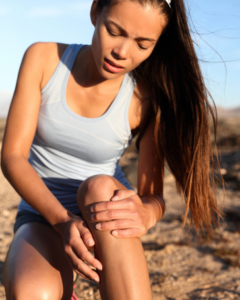
Knee pain and injuries can slow you down and hurt the quality of your life. The knee is one of the most critical and complex joints in the human body, playing a crucial role in mobility and supporting your weight during everyday activities and exercise. However, its intricate structure and constant use make it vulnerable to injuries. At OSMC, we specialize in diagnosing and treating knee injuries, helping patients recover mobility and quality of life. Below, we discuss the five most common knee injuries, their symptoms, and treatment options.
1. Anterior Cruciate Ligament (ACL) Injuries
An ACL injury is one of the most well-known knee injuries, particularly among athletes. The ACL is a critical ligament that stabilizes the knee, and injuries often occur during sports that involve sudden pivoting, awkward landings, or direct trauma. People who experience an ACL tear frequently report hearing a “popping” sound at the time of injury, followed by severe swelling, instability, and difficulty walking or bearing weight.
Treatment depends on the severity of the injury. Rest, bracing, and physical therapy can restore function for mild cases. Severe tears may require surgical reconstruction followed by a rehabilitation program. To prevent ACL injuries, exercises that strengthen the hamstrings and quadriceps can be beneficial.
2. Meniscus Tears
The meniscus is a C-shaped cartilage in the knee that cushions the thighbone (femur) and shinbone (tibia). Tears often result from sudden twisting or age-related degeneration. Symptoms include knee pain, swelling, stiffness, and difficulty straightening the knee, with possible locking or catching.
Treatment depends on the tear’s severity. Minor injuries may be managed with rest, ice, anti-inflammatory medications, and physical therapy, while severe tears often require arthroscopic surgery. To reduce the risk of meniscus tears, avoid excessive twisting and maintain proper exercise form.
3. Runner’s Knee
Runner’s knee, or patellofemoral pain syndrome (PFPS), causes pain around or behind the kneecap due to repetitive stress on the knee joint. Common among runners, it can also affect those who frequently bend their knees or engage in high-impact activities.
Symptoms include dull, aching pain in the front of the knee, worsened by running, squatting, or sitting for long periods. Popping or cracking sensations may also occur.
Causes include overuse, kneecap misalignment, muscle imbalances, or improper footwear. Treatment involves rest, ice, strengthening exercises, proper footwear, and gradually increasing activity levels. If you have knee pain, contact OSMC or visit one of our walk-in orthopedic clinics.
4. Knee Bursitis
Knee bursitis occurs when the tiny, fluid-filled sacs (bursae) cushion the knee joint and become inflamed. This condition often results from prolonged kneeling, repetitive pressure, or direct trauma to the knee. The symptoms of knee bursitis include swelling, warmth over the affected area, pain during movement or when pressure is applied, and sometimes redness.
Treatment usually begins with rest, ice, and elevation of the affected knee. Anti-inflammatory medications may help; more severe cases might require fluid aspiration or corticosteroid injections. Preventive measures include wearing knee pads during kneeling activities and taking regular breaks.
5. Osteoarthritis of the Knee
Osteoarthritis is a degenerative condition that causes cartilage in the knee joint to gradually break down, primarily due to aging or wear and tear. While it mostly affects older adults, younger individuals with prior knee injuries or repetitive stress can also be affected.
Common symptoms include persistent knee pain, stiffness, swelling, and limited range of motion.
Treatment focuses on symptom management and improving quality of life through lifestyle changes like weight loss and low-impact exercises. Pain relief may involve medications or injections, and advanced cases might require surgery, such as knee replacement. Staying active and maintaining a healthy weight can help reduce the risk of developing osteoarthritis.
When Should You Seek Medical Attention for Knee Pain?
If you experience severe pain, swelling, instability, or difficulty moving your knee, it’s essential to consult a medical professional. Early diagnosis and treatment are critical to preventing further damage and ensuring a smoother recovery.
At OSMC, we provide expert care for knee injuries, tailoring our treatments to meet each patient’s unique needs. From advanced diagnostic tools to minimally invasive surgical techniques and personalized rehabilitation programs, our team is here to help you return to your active lifestyle.
If you’re dealing with knee pain or injury, don’t wait. Contact OSMC today to schedule an appointment with one of our specialists and take the first step toward recovery.


